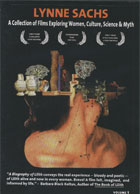
Lynne Sachs: A Collection of Films Exploring Women, Culture, Science & Myth 2005
Distributed by Microcinema International/Microcinema DVD, 1636 Bush St., Suite #2, SF, CA 94109; 415-447-9750
Produced by Lynne Sachs
Directed by Lynne Sachs
DVD, color, 60 min. +
College - Adult
Women's Studies, Jewish Studies
Date Entered: 12/21/2005
Reviewed by Debra Mandel, Head, Media Center, Northeastern University Libraries, Boston, MALynne Sach’s DVD-Rom is an interactive collection of films, poetry, audio interviews, visual collages, and autobiography. The key components are two 30 minute films, A Biography of Lilith, 1997, and The House of Science: A Museum of False Facts, 1991. Both films are 16mm transfers.
A Biography of Lilith tells the story of Eve from Kabbalistic and autobiographicall perspectives. In her introduction, Ms. Sachs states, “In a cinematic mix of off-beat narrative, collage, and memoir, this film updates the creation myth by telling the story of the first woman and for some, the first feminist.” Reminiscent of feminist experimental films from the 60’s and 70’s, Ms. Sachs punctuates her dreamlike, yet edgy narrative with an array of intimate symbolic images and sounds. Drumming and sequences of female nudity and sexuality are interspersed with dancing, pomegranate eating, singing, poetry, and biblical references. It is disjointed, muddy, jarring, and somewhat amateurishly filmed. White text used is sometimes unreadable, narration isn’t always audible. A Biography of Lilith is more an art piece than a coherent lesson, and its use in a classroom would need to be supported by a range of readings and media about Eve, Lynne Sachs, the Kabbalah, biblical texts, and feminist philosophy.
The second 30 minute darkly humorous film, The House of Science: A Museum of False Facts, explores women’s history in relation to medicine and science dogma and misinformation, using black and white footage from the 50’s, including scenes of women undergoing an ob/gyn exam, obtaining a diaphragm for birth control, and hearing lectures on the menstrual cycle. In addition are portrayals of women’s bodies being “cauldrons of dangerous substances” and images of women criminals and prostitutes.
Ms. Sachs also inserts her own personal story with respect to having a child. Though her clips and references provide interesting ironies, I was bored watching this film, perhaps because I had a difficult time following it. Possibly it could be used in women’s studies or film studies classes.
The additional materials on the DVD-ROM, include two abstract short films, one about her young daughter Maya, and one on window washing. One can use the DVD-Rom’s interactive menu to access the two main features, and the special features, which are the other films and interviews. One can also download and print out some of Lynne Sach’s poetry and a complete transcript for The House of Science.
This DVD-R is recommended with reservations. The content is sometimes interesting and imaginatively filmed and packaged. But the production values are very weak, and the use limited. I would recommend this material for Lynne Sachs researchers or for those whose collection stretches beyond traditional purchase criteria and include a range of experimental styles.